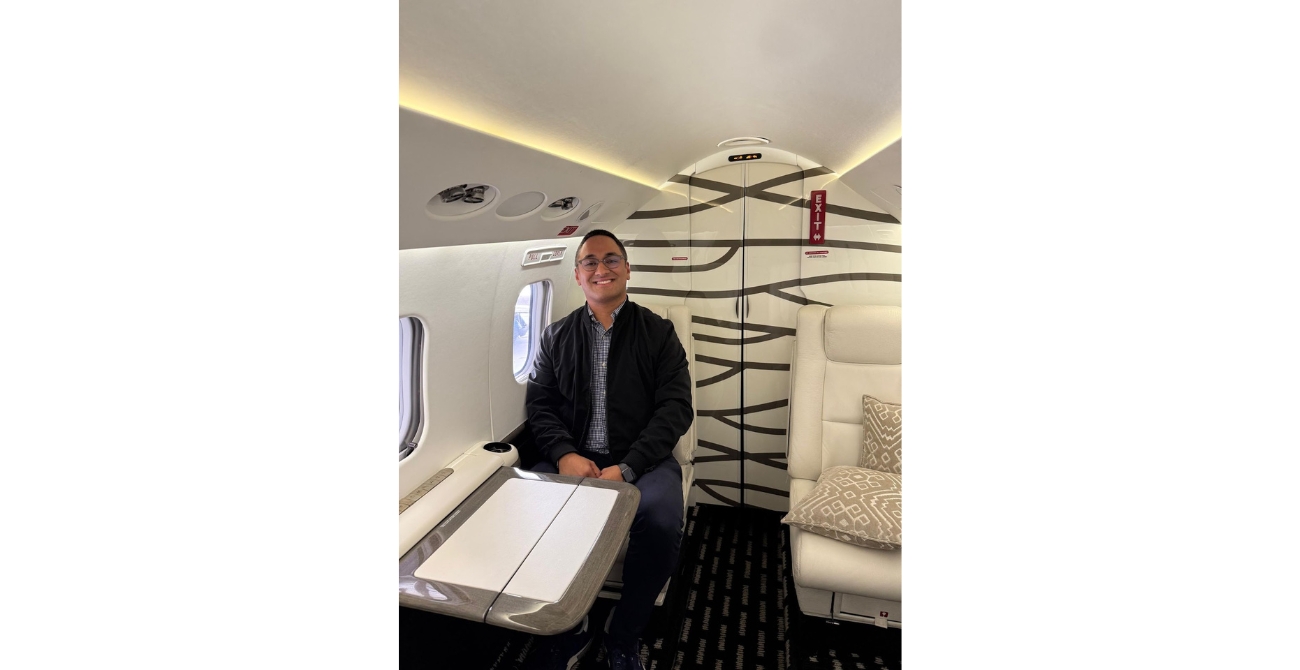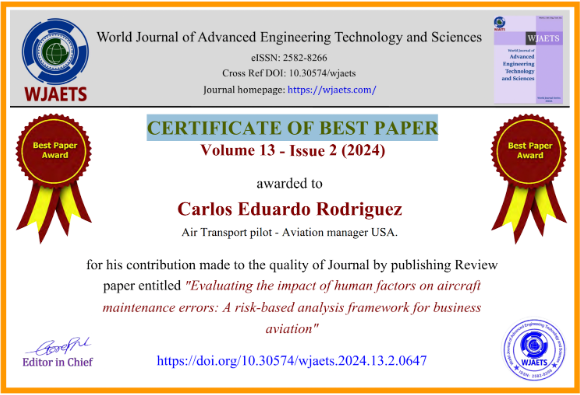In the high-gloss world of business aviation, cabin champagne and ultra-long-range performance often steal the spotlight. Yet, for Captain Carlos Eduardo Rodriguez Martinez, the unsung heroes are the technicians toiling under winglets at 3 a.m. His newly published research dives deep into why these professionals still commit errors—despite laser-aligned jigs, torque-controlled tools, and terabytes of OEM manuals—and what the industry must do to help them succeed.
The paper, published in the World Journal of Advanced Engineering Technology and Sciences (WJAETS) and honored with the journal’s Best Paper certificate for Volume 13, Issue 2 (2024), is titled “Evaluating the Impact of Human Factors on Aircraft Maintenance Errors: A Risk-Based Analysis Framework for Business Aviation.” Carlos Eduardo Rodriguez has explored the growing movement: shifting aviation safety’s center of gravity from hardware reliability to human reliability.
Core Thesis: Errors Are Symptoms, Not Sins
Rodriguez opens with a blunt assessment: Business-jet operators often borrow commercial-aviation processes without adjusting for smaller headcounts, compressed schedules, and diverse fleet types. In that environment, he argues, the traditional blame game—finding a scapegoat after an incident—merely treats the symptom.
His analysis instead categorizes maintenance errors into three systemic drivers:
- Physiological Limits: Fatigue, circadian disruption, and ergonomic strain.
- Cognitive Overload: Multitasking on heterogeneous aircraft models and last-minute client alterations.
- Cultural Latency: Punitive reporting climates that bury near-miss data.
Each driver is mapped against real-world case studies, producing a risk matrix that quantifies probability and severity. This empirical approach transforms “soft” human-factor discussions into hard metrics CFOs and Directors of Maintenance can rally behind.
The Three Pillars of Rodriguez’s Framework
- Just-Culture Implementation
By aligning accountability with system design rather than individual fault, the framework activates what Rodriguez calls “the silent data stream”—the 80 percent of minor glitches technicians currently fix quietly, without formal reporting.
- Technology as Cognitive Prosthetic
Unlike automation aimed at replacing labor, Rodriguez champions tools that augment human focus. Examples include AI-assisted troubleshooting devices that suggest probable fault trees, and digital checklists that lock progression until each item is confirmed via NFC-tag scanning.
- Adaptive, Competency-Based Training
Rodriguez attacks the “one-and-done” training mentality. His proposal: modular micro-learning refreshed quarterly, tied to error-trend analytics. Under-performance in, say, composite-repair steps triggers an automatically scheduled VR module simulating that exact task, followed by an in-person proficiency check.
The World Journal of Advanced Engineering Technology and Services is no vanity press; its editorial board includes former FAA administrators and leading MRO CTOs.
Award recipients have historically influenced:
- Regulatory Frameworks: Previous WJAETS best-paper concepts re-surfaced in EASA’s Part 145 guidance.
- OEM Design Roadmaps: Airbus and Embraer have both cited winning papers in subsequent human-machine-interface revisions.
- Insurance Risk Models: Underwriters increasingly weigh evidence-based human-factors programs when setting premiums.
By honoring Rodriguez, the journal signals that human-centric maintenance is shifting from academic theory to industry expectation.
Ripple Effects: Who Stands to Gain?
- Charter Start-Ups: Often lacking deep benches and standardized fleets, they can deploy Rodriguez’s modular framework as a turnkey safety differentiator.
- Maintenance Training Organizations: The demand for micro-learning and VR proficiency checks could spawn new curricula and licensing revenue streams.
- Technology Vendors: Fatigue-monitoring wearables and AI troubleshooting apps will find a receptive, evidence-driven market.
A Personal Mission Rooted in Cockpit, Hangar, and Boardroom
Rodriguez’s dual credentials—ATP pilot and aviation-management consultant—curate a rare 360-degree vantage point. He has clocked over 3,000 hours in platforms ranging from Citation Excels to Gulfstream G200s, founded Aero Servicios AC Corp (a sustainability-focused management firm), and launched Volark LLC to streamline parts logistics. Each venture has hammered home the same lesson: Safety margins erode fastest where human systems lag behind mechanical ones.
That conviction underpins the new research, and it resonates with the award committee’s citation praising his “risk-based, action-oriented contribution to aviation-maintenance literature.”
Implementation Roadmap: Four Steps for 2025
- Baseline Assessment: Operators deploy Rodriguez’s audit template to score current fatigue, training, and reporting protocols on a 1–5 scale.
- Quick-Win Tech Upgrades: Introduce digital checklists and tablet-based discrepancy snapshots, yielding immediate visibility gains.
- Just-Culture Workshops: Conduct leadership sessions that redefine accountability, backing them with policy updates that protect error reporters.
- Metrics & Feedback Loop: Use Rodriguez’s KPI dashboard to track error frequency, severity, and remediation cycle time—publishing quarterly “safety health” reports for transparency.
Early adopters stand to see incident reductions of 30–50 percent within two years, according to predictive models in the paper.
The Road Ahead
Plans are already under way for a multi-operator trial involving four U.S. charter firms and a Latin American fractional program. Rodriguez will serve as technical advisor, gathering real-time evidence on how his framework scales across cultures and aircraft types. Results are slated for presentation at NBAA-BACE 2025.
In an era when zero-emission propulsion and autonomous air-taxis dominate headlines, Rodriguez’s work is a timely reminder that aviation’s most complex system is still the human one. His award-winning paper doesn’t just enrich academic discourse; it hands operators a pragmatic manual for safeguarding the people who safeguard their aircraft.
The next time a business jet lifts off flawlessly at dawn, odds are it will owe a silent debt to technicians empowered by Captain Carlos Eduardo Rodriguez Martinez’s human-factors vision—and to the industry that recognized its value.






























